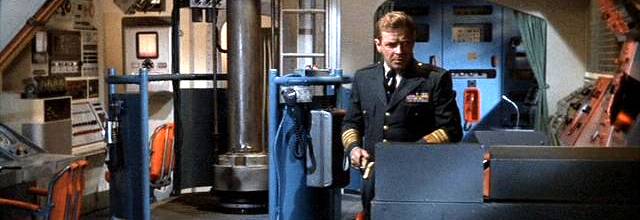
Nelson boards Seaview to find an empty boat.
Voyage to the Bottom of the Sea |
| The Death Watch Original Airdate: November 13, 1966 |

| In the dark of night, Nelson boards Seaview to find her apparently devoid of all crew. The intercom and radio are of no help, as no one answers. Exploring the sub, he discovers Sharkey asleep in the crew's quarters, and the Chief confuses him by saying he's been waiting for several hours and that it was Nelson's own orders that had dismissed the rest of the crew. |
| When Sharkey says he doesn't know where Crane is, Nelson decides he needs a gun. But, as Sharkey informs him, all weapons have been removed from the boat, once again by his own order. Nelson denies it and orders Sharkey to accompany him to the control room. Meanwhile, the shadowy figure of Crane sneaks aboard Seaview; he is most definitely armed with a gun. |  Crane sneaks aboard. |
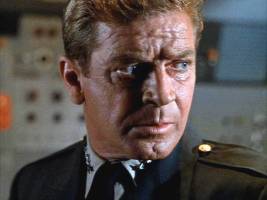 |
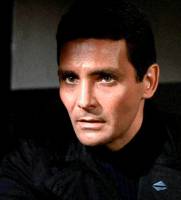 |
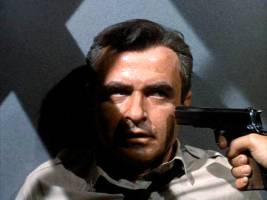 |
"The Death Watch" is the director's show. Despite weak writing and plot holes, practically every scene is visually strong. |
|
Crane confronts Sharkey and accuses him of working with Nelson to plot against him and demands to know the Admiral's whereabouts. He, as has Nelson, hears a high-pitched squealing message which the chief seems not to hear, is further agitated and finally admits he wants to kill the Admiral. Sharkey tries to convince Nelson to get off the sub, but there seems to be no escape--all the hatches are locked. It's not long before Crane catches up to Nelson and puts a bullet in him. Sharkey intercedes before the captain can kill Nelson. Crane knocks down Sharkey and resumes his search for Nelson. (You get the idea -- lots of |
| back and forth cat and mouse.) About this time, a sultry voice announces Seaview is setting to sea, which indeed, the uncrewed sub does. |
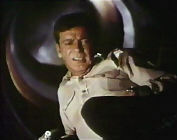 |
|
|
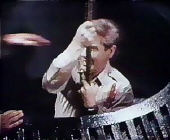 |
|
Climactic end, where the music perks up and Nelson is almost killed, but Sharkey saves the day. |
| Things culminate when Nelson, tiring of the game, and intent on eliminating Crane, challenges the Captain to meet him in the control room. The truth starts to dawn on Nelson when he dwells on the word control, and finally remembers that they're part of a mind-control experiment to which Sharkey is the control. But that control is taken out of the loop when Crane manages to lock the chief up and it begins to look like Crane may succeed in killing his wounded and thus weakened Admiral by drowning him in the pressurized escape room. A desperate fight between Nelson and Crane ensues until, just in time, Sharkey escapes and plays the tape which calls the experiment to an end. Crane and Nelson are free. |
![]()
|
Mark Says: You almost have to admire the audacious nerve of this episode. Nelson and Crane run around the empty ship, ostensibly to kill each other, but the real point is to kill time and keep the production budget low. On that level, it’s annoying. Yet Leonard Horn was a superb director who establishes some measure of nightmarish tension and it’s kind of fun to see Nelson emerging from his hypnotic fog and try to reason with Crane (Hedison excels here – a scary, obsessed, unreasoning visage of murderous fury). The episode definitely has its moments. |
 "Nothing makes sense anymore." |
Mike Says: Idea with low-budget potential, but shaky writing. Nelson does and says things totally out of character right from the start – his frustrated blustering gets old quickly. Please note, I am not criticizing the acting, but rather the words put in the actors' mouths and the motivations behind them. Sharkey's unexplained quizzical reactions likewise. Things aren't playing right, and the viewer knows it. As the Chief says at one point, "Nothing makes sense anymore. What's going on around here?" This is an episode which could have benefited from a cracklingly eerie soundtrack to prop up the weak writing, but the canned-sounding cues, attributed in the credits to Voyage nemesis Lennie Hayton, just noodle ponderously along. The thing that makes this outing worth watching, as Mark points out, is the sharp directing of Leonard Horn, right down to the |
| hand-held camera sequence of Crane disabling the Flying Sub. This was back when hand-held camera was used purposively as a psychological device, not as a budget-dictated necessity. Again, the acting is strong throughout, in spite of weak and illogical dialogue. And golly gee, a season-three show that doesn't start with a UFO crashing into the ocean and with no rubber-suited monsters. That part is pretty cool as is this episode in general, in spite of all my carping. |
|
|
| "Voyage to the Bottom of the Sea" ® is a registered trademark of Irwin Allen Properties, LLC. © Irwin Allen Properties, LLC and Twentieth Century Fox Film Corporation. All rights reserved. |